At the top, Manchester City had 47 points -- three points ahead of Liverpool, who were three points ahead of Chelsea. Chelsea had to make up six points on City and leapfrog Liverpool, but they'd had success against both sides in recent seasons, and just a couple positive results would've been enough to make up the gap. With those three sides presumably fighting for first, the rest of the Big Six was left to fend for the fourth and final Champions League place. Arsenal and Tottenham were tied on 35 points, with Manchester United one back on 34.
While the table promised a frenetic multifront fight for the two most valuable spots in the table, it didn't quite turn out that way. Liverpool and City pushed each other all the way until the final whistle of the final game and ended up one point apart, but Chelsea finished a full 18 points back of second. The fight for fourth ended up the same way: Spurs topped Arsenal by two points, and United finished sixth, 11 points back of fifth.
If only there were a way to see this coming -- well, there was, and there is. Nineteen games into the season, the best predictor of future results isn't current points. No, it's expected goals. And halfway through last season, City and Liverpool had xG differentials in the plus-35 range, while Chelsea were down at plus-19. As for the battle for fourth, Arsenal and Spurs were both right around plus-5, while United were down at minus-1.5. There were clear gaps in underlying performance between these teams, and over the second half of last season, that finally showed up in the results. It doesn't always happen, but it's more likely than not.
Now that we've reached the halfway point of the current season, who might improve and who might decline? Let's take a look.
All stats via Stats Perform
The team most likely to improve
There's one clear candidate for positive regression in the second half of the season, and it's David Moyes's West Ham United. In fact, we already saw some of it this past weekend.
- Stream on ESPN+: LaLiga, Bundesliga, more (U.S.)
On paper, the Everton-West Ham game was a matchup between two profligate teams in the relegation zone. But come the final whistle, it looked like a top-half-of-the-table side dispatching one of the worst sides in the league.
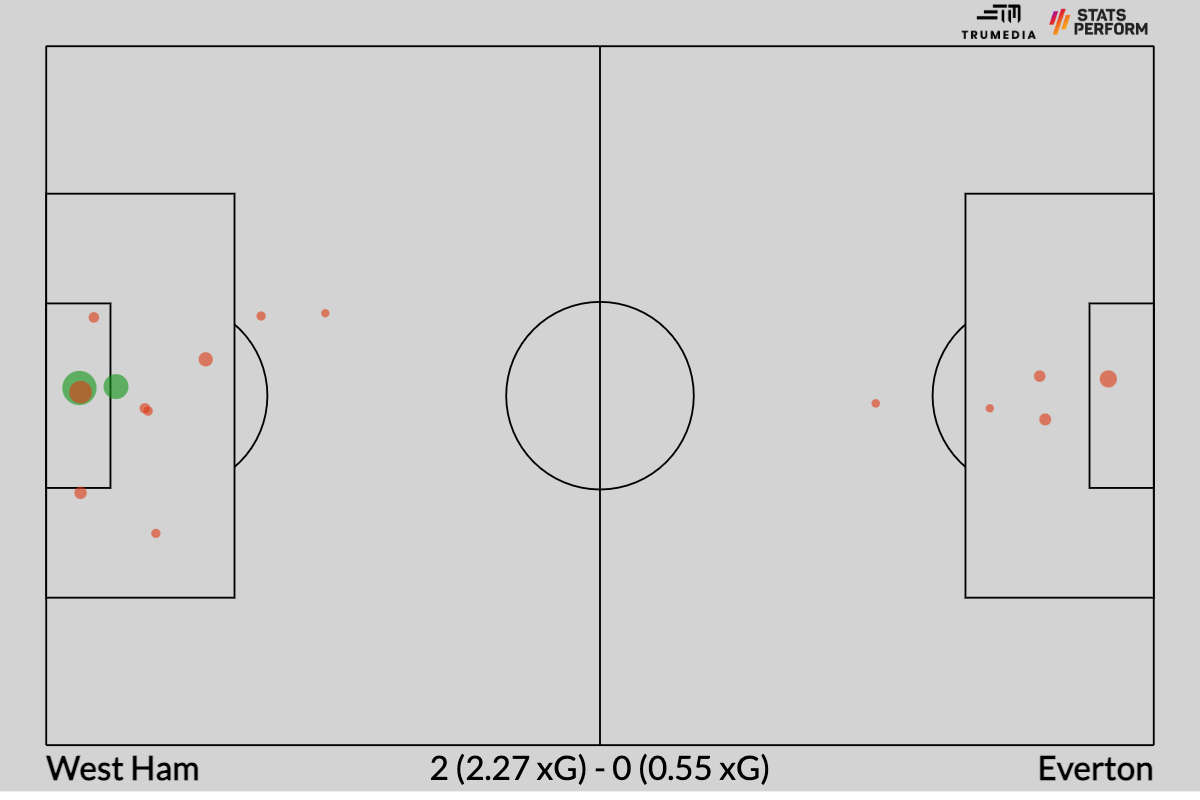
And really, that's kind of what it was. Despite rumors surrounding Moyes' job security, his team's underlying performance has been slightly better than in each of the previous two seasons when the Hammers looked like they might have an outside shot at finishing top four.
20-21: plus-0.20 xG differential per game
21-22: plus-0.01 xG differential per game
22-23: plus-0.21 xG differential per game
Although West Ham have created the 10th-most xG in the league so far this season, only three other teams have scored fewer goals. Almost all of the discrepancy lands on poor Jarrod Bowen.
After earning his first four England caps in 2022, the 26-year-old's production has cratered this season and might have cost him a spot at the World Cup.
20-21: 0.46 non-penalty goals+assists per 90 minutes
21-22: 0.66 non-penalty goals+assists per 90 minutes
22-23: 0.16 non-penalty goals+assists per 90 minutes
You can probably sense where this is going: it's random noise!
20-21: 0.42 non-penalty expected goals+expected assists per 90 minutes
21-22: 0.58 non-penalty expected goals+expected assists per 90 minutes
22-23: 0.41 non-penalty expected goals+expected assists per 90 minutes
Bowen hasn't been quite as good as last season, but he has been way better than three non-penalty goals and zero assists. He has taken 43 shots worth 5.2 xG, but more than that, he has created 2.9 expected assists. His teammates have turned that into zero goals. For comparison, Manchester United's Christian Eriksen has created 3.0 expected assists, and his teammates have turned that into seven assists. However, Bowen's two goals against Everton suggest it's already starting to turn around.
At the other end, West Ham have conceded the fourth-fewest xG (22.65) but have allowed 25 actual goals. Add up their underperformance at both ends, and their goal differential (minus-8) is 12.16 goals behind their xG differential (plus-4.16). That's the biggest negative gap in the league. Yes, they're still only two points clear of 18th, but they're the only team outside of the top nine in the league with a positive xG differential.
Barring a sudden collapse or a continuation of what would be a historically bad run of finishing, the Hammers should rise up the table over the next few months.
The team most likely to decline
If you just swapped Fulham and West Ham in the table, everything would make a lot more sense. Through 21 matches, Marco Silva's team is the only one in the league to exceed both their expected goals scored and conceded by two goals or more.
After undershooting his xG by about six goals over the course of his first two Premier League seasons, Aleksandar Mitrovic has eight non-penalty goals from 6.6 xG. Of course, he has brought himself back to his previous levels by missing three of the six penalties he has attempted. Meanwhile, Joao Palhinha, in his first season in the Premier League, has already matched his career high in goals, with three on just 1.98 xG.
The bigger positive bounce, though, comes when the other team has the ball.
Fulham have conceded 36.92 xG -- the worst mark in the league. And yet they've conceded 30 goals -- the 13th fewest in the league. Some of that comes from poor opponent finishing. Based on where the shots ended up on the goal frame, opponent shooting has lowered their xG down to 35.51. But the rest of it comes from a lights-out shot-stopping season from Bernd Leno, who has prevented more goals (goals allowed, subtracted from xG on target) than everyone other than Chelsea's Kepa and Liverpool's Alisson.
(Purple are saves; the larger the circle, the higher the xG value)
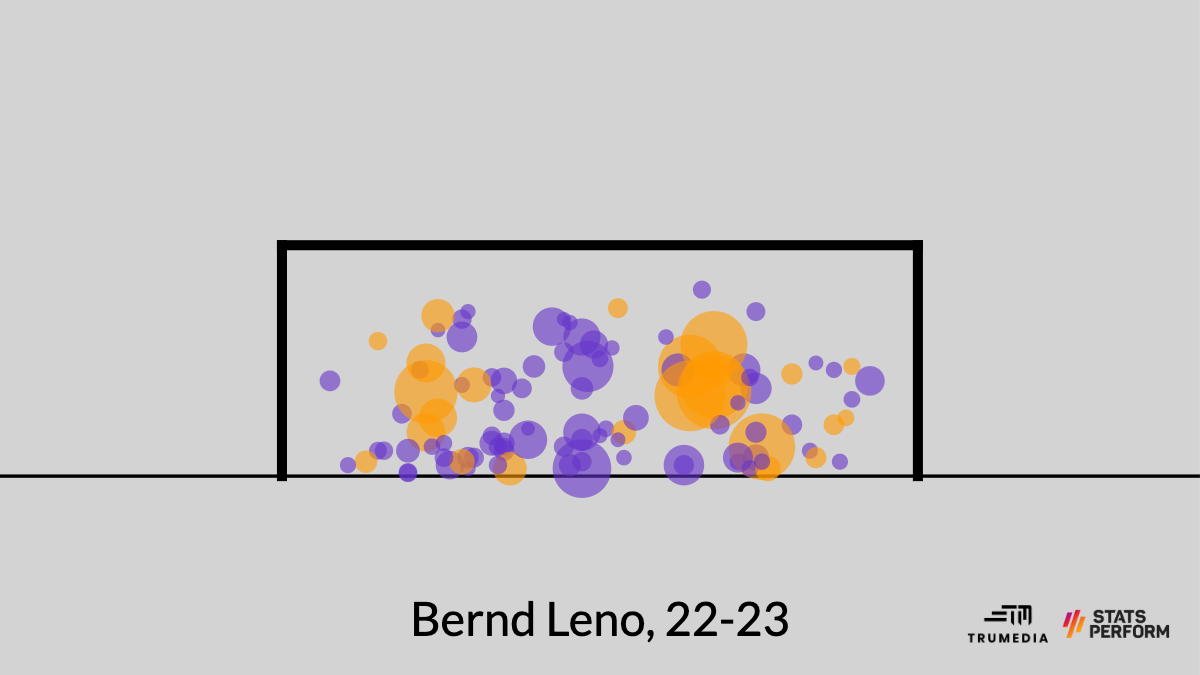
However, Leno has prevented more goals this season than in any year dating back to his final campaign with Bayer Leverkusen in 2017-18. Over his career, he has been a roughly average shot-stopper, so it seems unlikely to continue. The same goes for Fulham's overall form: their goal differential (plus-2) is 9.77 goals better than their xG differential (minus-7.77). No other team even has an eight-goal gap between the two.
Despite what's likely an impending drop-off, it won't make much of a difference overall. Fulham shouldn't be the Europa League contender the table suggests they are -- they're currently seventh! -- but they're also no longer the relegation fodder they've been in the past and were expected to be before this season. FiveThirtyEight puts their odds of relegation at less than 1%.
Across the rest of the league, there are some similar dynamics at play. Here's a plot of each team's xG differential and their points won, with a trendline suggesting roughly how many points we should expect for a team based on their underlying performance:
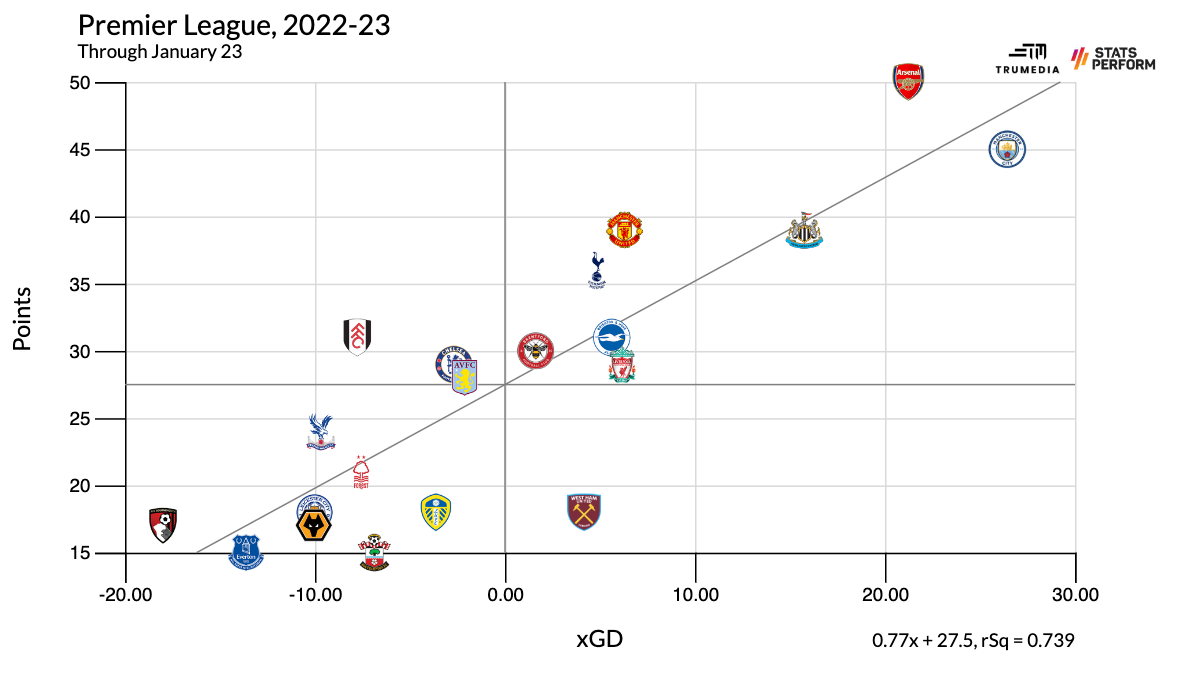
We should probably expect Man City to close the gap on Arsenal, but ... well, we all already expect that to some degree, don't we? Plus, it doesn't mean the Gunners are due any kind of collapse, either.
In third, Newcastle look safe to keep it running. In fourth, Manchester United haven't been as good as their point total suggests, but they've still been roughly as good as the three teams -- Liverpool, Tottenham and Brighton -- chasing them, and they have a sizable three-point cushion ahead of Spurs in fifth, with a game in hand. When four teams are roughly equivalent, you want to be the one that has a three-point lead.
Lower down the table, Leeds don't quite seem like a true relegation-level team and Southampton haven't quite been a worst-in-the-league-level team. No, that distinction belongs to either Everton or Bournemouth. Perhaps the Saints could bounce back in the second half, but outside of a new manager in Merseyside, there's not much to cling to for the other teams currently in the bottom three.
Players most likely to improve and decline
Over the past half-decade, a pair of clubs have raised the bar for what it means to be a title-winning Premier League team, and they've redefined exactly how you do it. One side exerted never-before-seen levels of control of its matches, while the other threw their matches into never-before-seen levels of chaos.
What united the two of them, though, was how they took one of the most sacred tenets of English soccer -- the mighty target man, a proper No. 9 -- and threw it in the trash. Neither side played with a traditional center-forward, and both sides managed to score 90-plus goals and win 90 points last season.
But perhaps sensing a shift -- a shift of the league toward how they'd begun to play -- both teams zagged after years of zigging. Over this past summer, they each signed a pair of large center forwards on pricey contracts: a 6-foot-4 21-year-old for €60 million and a 6-foot-2 23-year-old for €80 million. And while neither one touches the ball all that much, they've been the two most dangerous attackers in the league when they've been on the field.
The 23-year-old leads the league in non-penalty xG+xA per 90 minutes (1.07), while the 21-year-old is second at 0.97. No one else is above 0.82. And given all the success both teams have had in previous seasons, you'd assume that they'd both be just as good -- if not even better -- with two efficient goal producers added atop what were already high-functioning systems.
You, of course, would be wrong.
The 21-year-old is Manchester City's Erling Haaland, who has scored 25 goals in just 20 matches and is on pace to absolutely shatter the Premier League's 38-game scoring record of 32. Remember: this is only year one. If he doesn't go on to become one of the greatest soccer players of all time, it already feels like that would be a massive disappointment.
The 23-year-old is Liverpool's Darwin Núñez, who has scored five goals for a team that sits in ninth place through 19 games.
If you walked into any pub in England and repeated the same phrase about Núñez -- "If he doesn't go on to become one of the greatest soccer players of all time, it already feels like that would be a massive disappointment" -- then you'd get laughed out of the room, perhaps even if Núñez's family was visiting from Uruguay and had rented out that specific room of this theoretical pub for themselves. Liverpool's club-record signing has spent most of his first season in England looking like he doesn't have any feeling in either of his feet.
Now, it is misleading to compare Haaland and Núñez via per-90 numbers, as the former has played 1,546 minutes to the latter's 899. But when he has been on the field, Núñez has created better goal-scoring opportunities than anyone else in the Premier League -- including the guy with 25 goals. Núñez ranks third in the league in non-penalty xG per 90 (0.74) and fourth in the league in xA per 90 (0.33). His teammates have turned his 3.3 expected assists into just two goals, while he has turned his 7.4 expected goals into just five goals.
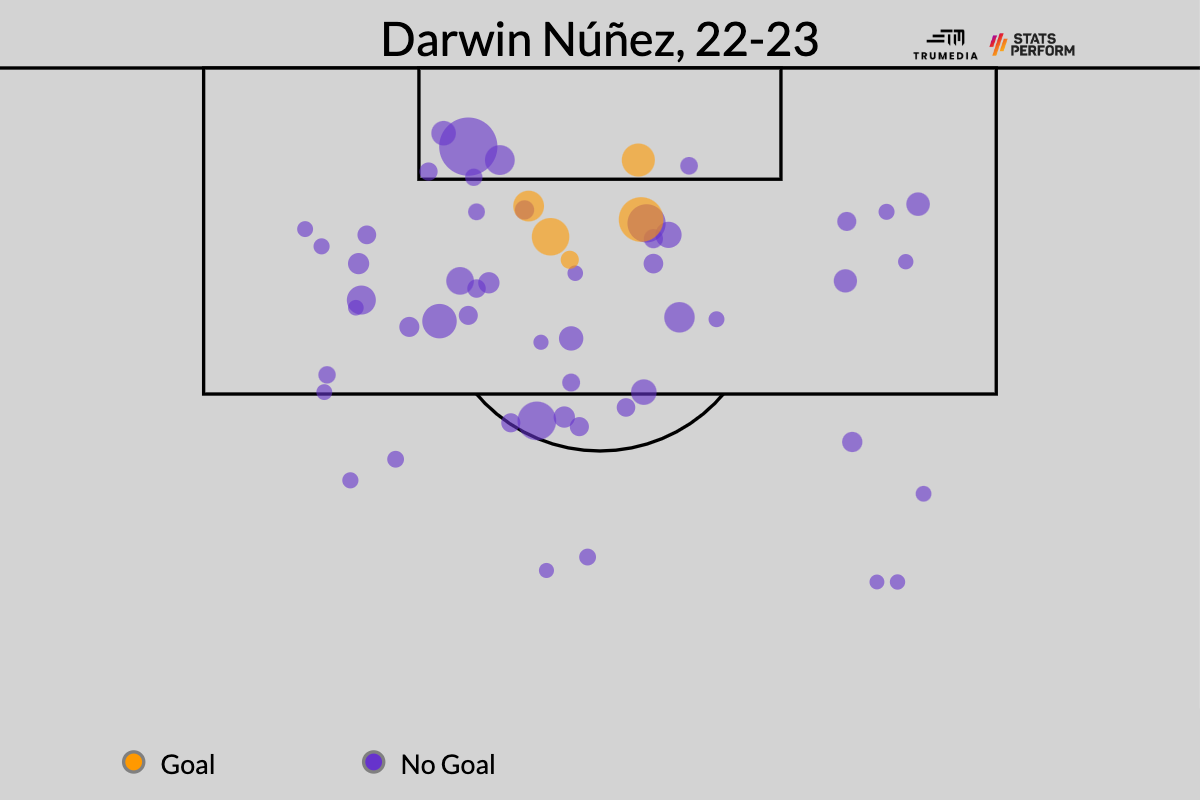
Haaland, meanwhile, has three assists from 2.9 expected, and he has scored 21 non-penalty goals from 13.7 expected.
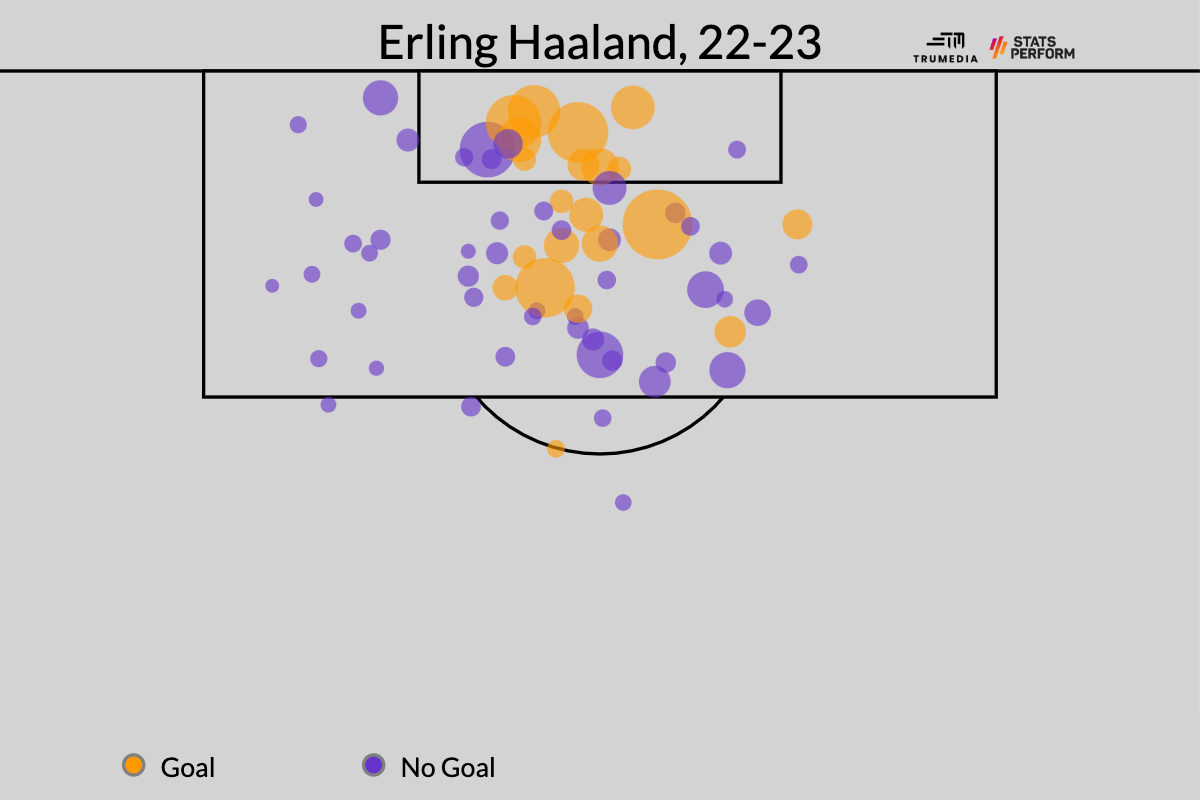
It's fair to say Haaland seems like he probably is an above-average finisher. In his two full Bundesliga seasons with Borussia Dortmund, he scored seven more goals than expected, combined. But in just 20 Premier League games, he has already scored 7.3 more than expected -- by far the biggest gap in the league. He's probably going to significantly cool off at some point, and he's also probably still going to score more goals than anyone else in the league from here on out. Both of those things can be true.
As for Darwin? He undershot his xG by four goals with Benfica two seasons ago, and then overshot it by 6.8 goals last year. Perhaps he is an especially streaky finisher -- prone to long hot and cold runs -- but it seems unlikely that we'll keep seeing what we've seen this season: an actively bad finisher.
I think there are still plenty of questions about how Núñez affects Liverpool's overall solidity around the field, but provided he continues to get playing time, the most likely outcome for the rest of the season is that he starts finishing his chances and his teammates do the same for the ones he sets up for them. By the end of the season, don't be surprised if we're talking about him like he's one of the best players in the league.
